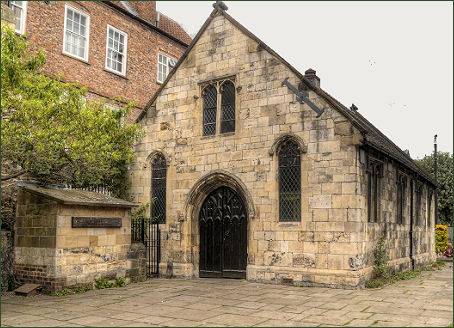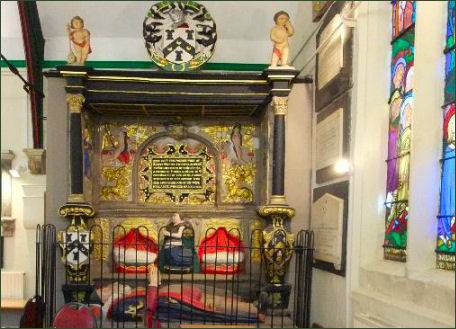St. Crux Parish Room, York
The small building, known as St. Crux Parish Room stands on Pavement and is used as a tea-room and sales venue for charitable purposes. The building is situated between the Shambles and Whip-ma-whop-ma-gate.


This Grade II listed building was erected in 1888, from the remains of the great medieval church of St. Crux, literally Holy Cross, the site of which it marks. The church was closed around 1880 after becoming unsafe, the tower began to lean dangerously. Attempts to raise money to repair it were unsuccessful, which sadly led to its demolition in 1886.
The small parish room houses a crowded but impressive array of colourful monuments and brasses saved from Holy Cross Church. The most splendid of the surviving monument in St Crux, is the tomb of Robert Welles, who was twice Lord Mayor of York and who died in 1612. There is also one to Thomas Bowes who was Lord Mayor of York in 1761 and whose shield incorporates the arrowheads and bows elements, which are found in the Bowes-Lyon Arms of the Queen Mother. The fifteenth century lectern and Royal Coat of Arms were given to All Saints’ Church.
Part of the stone wall of the fifteenth-century north aisle is still to be seen, and forms part of the southern exterior wall of no. 23 the Shambles and of the south wall of the Snickelway which leads to Whip-Ma-Whop-Ma Gate.
St. Crux was one of York's finest places of worship and the burial place of the Thomas Percy, 7th Earl of Northumberland. Mostly dating from 1424, its, once well-known, Italianate Tower was said to have been designed by Sir Christopher Wren in 1697.
Anglo-Scandinavian carvings from the site show its ancient origins. Fragments of a pre-Domesday Saxon cross have been found on the site.
Churches of York
Abbeys and Churches of Yorkshire
Back to Top
